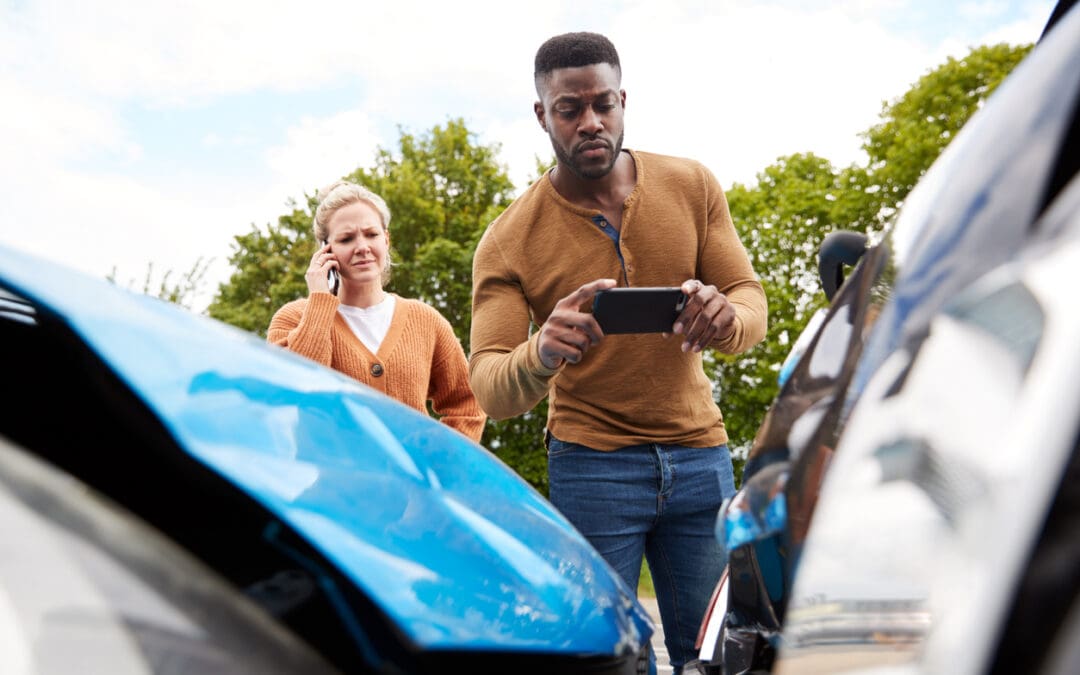What to Do After a Car Accident: A Step-by-Step Guide

The odds of getting into a car accident are high for all regular drivers. Read our blog to discover 5 practical steps you can take right after the scene of a crash to contain the damage and get a jump-start on the path to recovery.
The statistics leave little room for doubt–if you are a regular driver, sooner or later you will most likely be involved in a car crash. There are between 6 and 10 million motor vehicle accidents each year. As a result, 3 million people annually get injured–and around two-thirds of these injuries are permanent. According to Forbes magazine, data from the car insurance industry indicates that the average driver will file a claim for a collision about once every 17.9 years. This translates into the average person facing his or her first car crash by the age of 34 (assuming that a person receives a license at the age of 16) and a total of 3 to 4 accidents over a lifetime of driving experience.
While the data mentioned above makes a car accident seem inevitable, you can still do much to decrease your own probability of getting into a crash. For example, you can take precautionary measures by practicing defensive driving, performing regular maintenance of your car, and avoiding all kinds of driving distractions. Taking other measures such as always buckling up obeying the speed limit are also proven ways of minimizing the risk of serious injury in case an accident does happen.
In any case, preparation is the key. Due to extreme stress and a sudden surge of adrenaline in the body, many accident victims may find it difficult to act rationally after the accident. They may make rushed, emotional decisions instead, which can have dramatic consequences for their immediate safety as well as their long-term health and even their financial situation. To avoid such costly mistakes, you need to know exactly what to do in the event of a crash. In this article, we present 4 practical steps you should be sure to take if you ever get into a car accident.
Step 1: Ensure the Safety of Yourself and Others
In every accident situation, safety should be of utmost priority. Actions to ensure the safety of yourself, your passengers, other participants of the crash as well as other users of the road should, therefore, take precedence over everything else.
First, check yourself for signs of any injuries. Move carefully so as to not aggravate any unobvious ones–the adrenaline pumping in your veins may make you temporarily insensitive to pain and other signals your body may try to send you to warn you of a health issue. If you are obviously and seriously injured, try to move as little as you can while you await the arrival of emergency personnel.
If you are uninjured or if your injuries are minor (bruises, scratches, etc.), your next step would be to help your passengers and see if anyone needs urgent medical care. If someone is seriously injured, it is better not to move the individual before the first responders come, unless the location poses any immediate danger. Similarly, you should also check on the driver and passengers of the other car, or cars, involved in the crash. If needed, you should call 911 as soon as possible or ask someone else to do so.
If no one got seriously injured, you should also evaluate your surroundings to assess whether the aftermath of the accident may pose any immediate threat to other users of the road. If the location of the cars involved in the crash may put others at risk, you should move them to the side of the road or to the nearest safe spot.
Step 2: Contact the Police
In New Mexico, the driver of a car involved in an accident is obliged by law to report the incident to the police, depending on the circumstances. This is required if:
- The accident results in bodily injury or death
- The apparent property damage could exceed $500 in value
Even if neither of the above conditions are met, contacting the police is still usually advisable. This is due to the fact that bodily injury may manifest itself some time after the accident. In such a case, the report of the accident made by the police may help the injured party with a personal injury claim against the at-fault driver.
Step 3: Get the Basic Data
The decision lies with you, the injured person–the decision whether or not to file a personal injury claim against the person that may be responsible for the accident and liable for any resulting injuries. You may need some time after the accident to decide whether or not to take advantage of this legal right. If you were injured in a car crash, though, it would be wise to start gathering certain information with the view of a potential legal action right at the scene of the accident.
The most basic and, at the same time, the most essential information you must obtain is the personal data of the other driver involved in the crash. These should include:
- Full name and contact information (address, telephone, e-mail)
- Insurance company name and liability insurance policy number
- Driver’s license and license plate number
While talking to the other driver to get this information, keep things matter-of-fact. Remain polite but be careful not to engage in a relaxed conversation or offer opinions on the accident. Especially avoid any statements that later in the court may be taken as an admission of guilt. You should even refrain from saying, “I’m sorry,” as your words may later be construed in a way that could adversely affect your claim.
Step 4: Document the Accident
The work towards a strong personal injury claim may start right at the scene of the accident. Thanks to your phone, you may start gathering important evidence that will later serve your lawyer in the preparation of a strong case. Therefore, you should not hesitate to document everything you can by taking pictures or videos clearly showing the following:
- Your injuries
- Any property damage to your car
- The other driver’s car
- The scene of the crash and its surroundings
If there are any people around who witnessed the accident, you should approach them to at least obtain their personal information so that they can be contacted at a later time.
Step 5: Medical Checkup
Once the dust of the accident has settled–both literally and proverbially–and you’re able to leave the scene of the crash, you should go straight to the nearest medical provider for a standard medical checkup. Many accident victims decide to skip this step, often to their long-lasting detriment.
As mentioned before, some injuries may become apparent only later on. That is why it is so important to ensure that you are safe and don’t require any immediate medical attention. A medical checkup will allow the doctor to see how much of an impact the accident has had on your health and give you any immediate treatment recommendations if necessary. Having a proper medical checkup after the accident will start you up on the road to recovery and can even save your life!
Car accidents are stressful experiences that always entail some negative impact on a person’s life. Nevertheless, by following the advice in this blog, you may be able to contain any damage an accident may cause you and quickly get on the path of complete and successful recovery.
Why Choose Ron Bell Injury Lawyers?
We Get Results!
